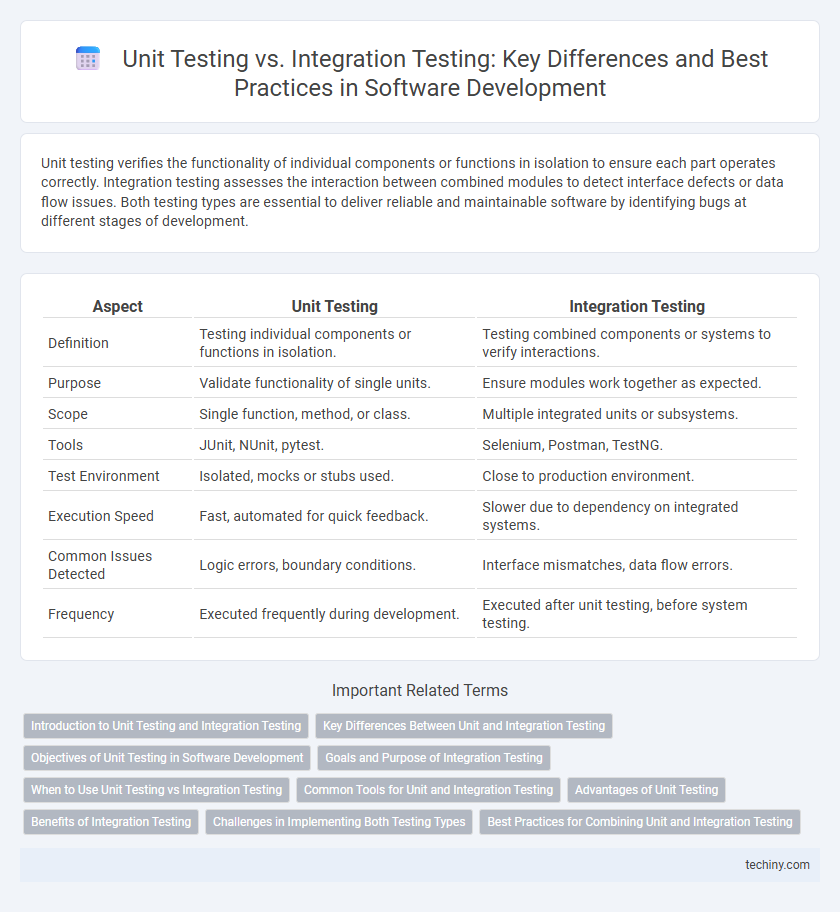Unit testing verifies the functionality of individual components or functions in isolation to ensure each part operates correctly. Integration testing assesses the interaction between combined modules to detect interface defects or data flow issues. Both testing types are essential to deliver reliable and maintainable software by identifying bugs at different stages of development.
Table of Comparison
| Aspect | Unit Testing | Integration Testing |
|---|---|---|
| Definition | Testing individual components or functions in isolation. | Testing combined components or systems to verify interactions. |
| Purpose | Validate functionality of single units. | Ensure modules work together as expected. |
| Scope | Single function, method, or class. | Multiple integrated units or subsystems. |
| Tools | JUnit, NUnit, pytest. | Selenium, Postman, TestNG. |
| Test Environment | Isolated, mocks or stubs used. | Close to production environment. |
| Execution Speed | Fast, automated for quick feedback. | Slower due to dependency on integrated systems. |
| Common Issues Detected | Logic errors, boundary conditions. | Interface mismatches, data flow errors. |
| Frequency | Executed frequently during development. | Executed after unit testing, before system testing. |
Introduction to Unit Testing and Integration Testing
Unit testing involves verifying individual components or functions of software to ensure they perform as intended, focusing on isolation and code correctness. Integration testing evaluates the combined behavior of multiple units or modules, detecting interface defects and interaction issues between integrated parts. Both testing types are essential to maintain software quality, with unit tests targeting internal logic and integration tests confirming system cohesiveness.
Key Differences Between Unit and Integration Testing
Unit testing isolates individual components or functions to verify their correctness, primarily focusing on small code sections and ensuring they perform as expected. Integration testing evaluates combined modules by examining their interactions and data flow, detecting issues in communication between integrated units. While unit tests prioritize internal logic validation, integration tests emphasize system interoperability and interaction correctness.
Objectives of Unit Testing in Software Development
Unit testing in software development aims to validate the functionality of individual components or modules by isolating them from the rest of the system. This process ensures that each unit performs as expected, detecting and fixing bugs early in the development cycle. Effective unit testing improves code quality, facilitates refactoring, and reduces integration errors, ultimately enhancing software reliability.
Goals and Purpose of Integration Testing
Integration testing aims to verify the interactions between integrated units or components to ensure they function together correctly, identifying interface defects and data flow issues. Its primary goal is to detect problems that unit testing might miss by validating combined modules in various real-world scenarios. This testing phase confirms the system's reliability, performance, and compliance with requirements before full-scale deployment.
When to Use Unit Testing vs Integration Testing
Unit testing is most effective during the initial coding phase to validate individual functions and methods for correctness and reliability. Integration testing should be employed after unit tests are complete, focusing on verifying the interaction and data flow between multiple modules or services. Prioritizing unit tests supports early bug detection, while integration tests ensure system components work together as intended in real-world scenarios.
Common Tools for Unit and Integration Testing
Popular tools for unit testing include JUnit for Java, NUnit for .NET, and Jest for JavaScript, each providing robust frameworks to isolate and test individual components. Integration testing often employs tools like Selenium, Postman, and TestNG to validate the interaction between multiple modules and external systems. Continuous integration platforms such as Jenkins and Travis CI facilitate automated execution of both unit and integration tests, enhancing software reliability.
Advantages of Unit Testing
Unit testing offers precise identification of code defects by isolating individual functions or methods, enabling faster debugging and higher code quality. It facilitates test-driven development (TDD), improving design clarity and ensuring each component meets its requirements before integration. Automated unit tests reduce regression risks, enhance maintainability, and accelerate development cycles in complex software projects.
Benefits of Integration Testing
Integration testing enhances software reliability by verifying that different modules or components work together as intended, identifying interface defects that unit testing may miss. It helps detect issues related to data flow, interaction between integrated units, and overall system behavior early in the development process. This testing reduces costly bugs in later stages, ensuring seamless communication across various software layers and improving overall application quality.
Challenges in Implementing Both Testing Types
Unit testing faces challenges such as isolating individual components from dependencies and creating comprehensive test cases that cover all possible input scenarios. Integration testing struggles with identifying the source of defects when multiple modules interact and ensuring the test environment accurately reflects production conditions. Both testing types require significant time investment and skilled resources to design, implement, and maintain effective test suites that deliver reliable software quality assurance.
Best Practices for Combining Unit and Integration Testing
Combining unit testing and integration testing optimizes software quality by ensuring individual components perform correctly and interact seamlessly in the system environment. Best practices include isolating unit tests to verify functionality independently while designing integration tests to validate interfaces and data flow between modules. Maintaining automated testing suites with clear coverage metrics, continuous integration pipelines, and regular refactoring promotes early defect detection and robust application performance.
Unit Testing vs Integration Testing Infographic

 techiny.com
techiny.com